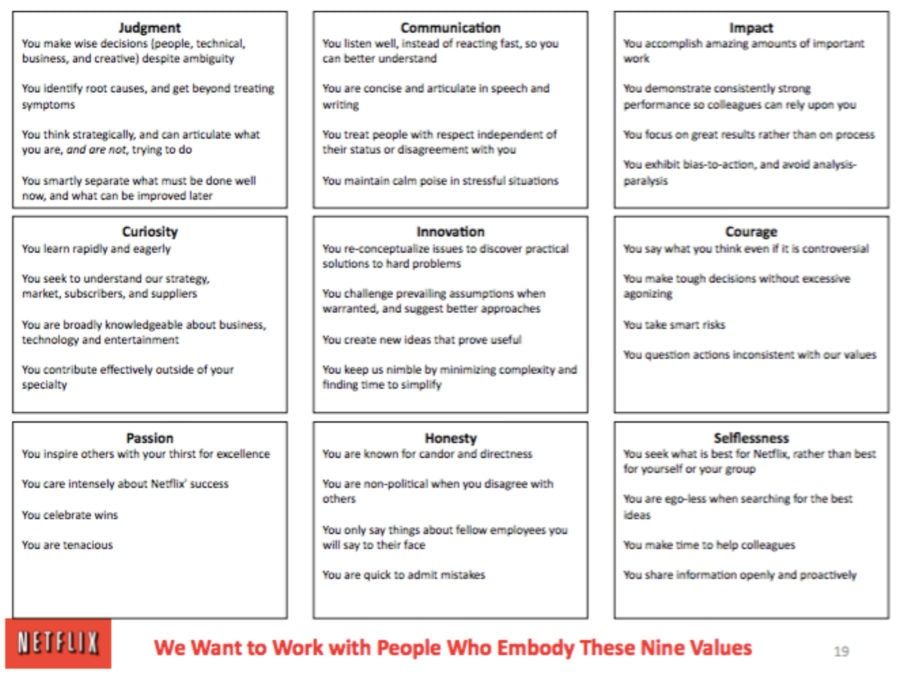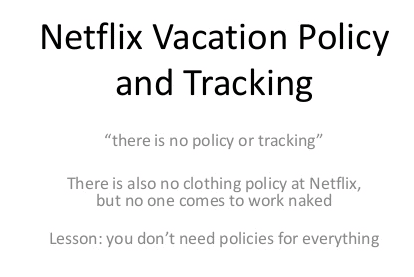Corporate Culture and HR Strategic Role

A recent podcast about “How to fix your company’s culture” grabbed my attention because it illustrates how rarely big corporations actually work on their culture. Although, I would say the “fixing” entails something is broken and I wouldn’t say that corporate culture could be broken. It might be mismatched with its environment or within itself (vision and values are not aligned with behaviors), or worse, your culture might just have faded away…
Nevertheless, this podcast is the very interesting interview of Patty McCord former Chief Talent Officer of Netflix. She’s sharing some insights about key fundamentals of a corporate culture.
The full podcast is here (read on and come back later to it).
The key point I’d like to highlight is that they are using a sleek tool they call a culture slide deck.
This deck is a compact reference about their core values. And each value is illustrated with its meaning by four behaviors that will demonstrate that value. This clarifies what is meant, it gives employees clear guidelines of what is valued, recognized, promoted, rewarded.
If you understand the value of being able to write your business model on the back of a napkin, well, this is essentially the same for your culture…
For Netflix, it goes like that:

There is a very strong and clear commitment when you say to your employees: « You identify root causes, and get beyond treating symptoms. » And each of these values can further be translated into something as simple, practical and striking as:

Most of the time, what we observe in companies is the list of broad values where you can’t really go wrong. Saying « Be nice to each other » is fine, but no meaning is actually attached to that. No translation, no materialization.
No commitment.
It is then left to employees to interpret and approximate. Or in some cases it becomes the opposite to compensate for the underlying fuzziness. And you get a long list of processes and rules that have lost their root intent and end up leaving no room for autonomy.
As I was mentioning in a full-stack approach it is key not only to identify your values in coherence with your vision and DNA. But also to give them meaning, a shared meaning which can take the form of explicit observable behaviors, or stories of people who demonstrated these values.
At that point you might think it’s an « HR thing », but what about using also these core values to engage your customers with what you deliver and how you do it?
Here is another example:
Innovation Is Motion What we do is that we work with those who change the market. Whether modestly or in a very radical way, they disturb, make waves and do what others tried without success. They walk off-the-beaten-track, and if they succeed, they alter the status quo. Innovation is not measured by the number of patents, but by the impact of its change. We believe that a restaurant chain can be more innovative than a pharmaceutical lab. And although we do love technology and recognize its transformative power, we do not see it as THE answer. Simply a tool amongst many.
Rings a bell? This is one of the three core values we’ve been explaining to our contacts for the last five years. We believe it’s not for everyone. That’s fine. It shouldn’t be, because vision and culture are not copy and paste items.
In the end, such synthetic and actionable set of values is a good acid test on how your culture is managed with strategic intent from within your company, and how it’s perceived from outside. It reflects your brand.
As we were saying, it’s not an « HR thing ». It doesn’t mean though that it’s not something you’d like to work on if you’re leading an HR department. No one should believe that HR has no strategic value. The question is more: what are you doing about it?





